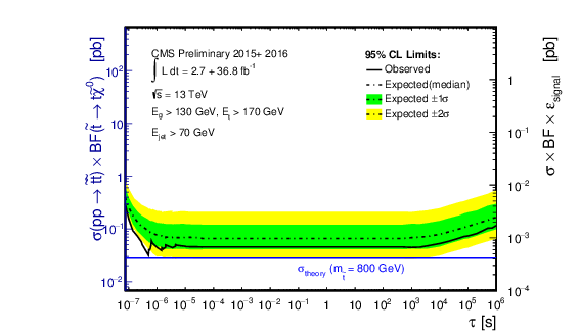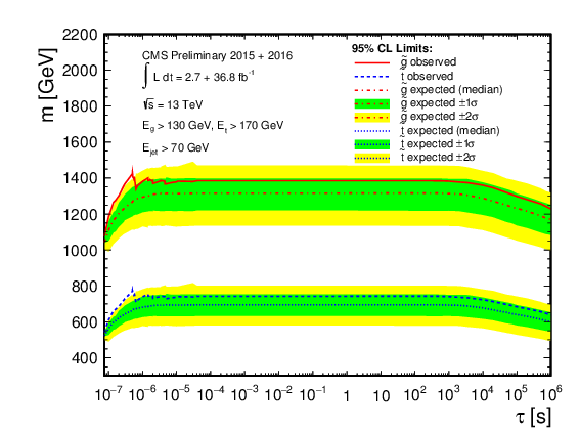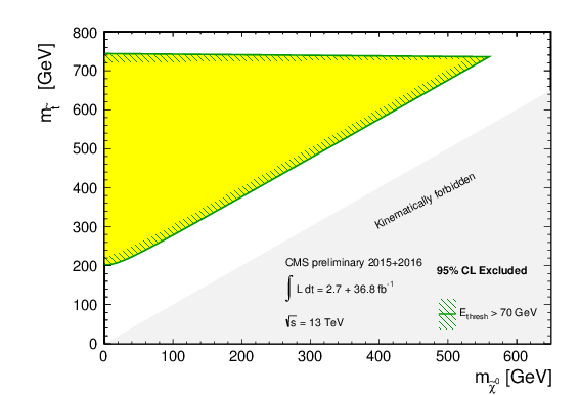

Compact Muon Solenoid
LHC, CERN
| CMS-PAS-EXO-16-004 | ||
| Search for stopped long-lived particles produced in pp collisions at $\sqrt{s}= $ 13 TeV | ||
| CMS Collaboration | ||
| May 2017 | ||
| Abstract: A search is presented for long-lived particles that lose sufficient kinetic energy and come to rest in the CMS detector. If such a particle decays to at least one standard model particle, it would produce a spectacular signature: a high-energy jet that is not coincident with the proton-proton collisions. During the time intervals without collisions, the detector is quiet and only rare background processes must be considered. The 2015 search is performed using a 2.7 fb$^{-1}$ sample of pp collision run data at $\sqrt{s}= $ 13 TeV, corresponding to 135 hours of trigger livetime, while the 2016 search is carried out using a 36.8 fb$^{-1}$ sample of pp collision run data at the same energy, which corresponds to 586 hours of trigger livetime. Four events are observed in the 2015 analysis and thirteen events are observed in the 2016 analysis; both observed numbers of events are consistent with the predicted backgrounds. Limits are placed on the mass of gluinos and stop quarks with lifetimes spanning 13 orders of magnitude. Assuming a cloud model of R-hadron interactions, and combining the results from the 2015 and 2016 analyses, for $E_{\mathrm{g}} > $ 130 GeV and $BR(\tilde{g} \rightarrow g\tilde{\chi}^0) = $ 100%, gluinos with lifetimes from 10 $\mu$s to 1000 s and $m_{\tilde{g}} < $ 1385 GeV are excluded. Under a similar assumption, $E_{\mathrm{t}} > $ 170 GeV and $BR(\tilde{t} \rightarrow t\tilde{\chi}^0) = $ 100%, we are able to exclude long-lived stop quarks with lifetimes from 10 $\mu$s to 1000 s and $m_{\tilde{t}} < $ 744 GeV. These are the strongest limits on stopped long-lived particles to date. | ||
|
Links:
CDS record (PDF) ;
CADI line (restricted) ;
These preliminary results are superseded in this paper, JHEP 05 (2018) 127. The superseded preliminary plots can be found here. |
||
| Figures | |

png pdf |
Figure 1:
$\varepsilon _{\mathrm {reco}}$ for $\tilde{g}$ and $\tilde{t}$ R-hadrons that stopped in the EB or HB as a function of energy of the SM daughter particle. The left plot corresponds to the 2015 MC simulation and the right one corresponds to the 2016 MC simulation. The difference between the two plots is due to the removal of the beam halo filter in the trigger in 2016. The shaded areas correspond to the systematic uncertainties. |

png pdf |
Figure 1-a:
$\varepsilon _{\mathrm {reco}}$ for $\tilde{g}$ and $\tilde{t}$ R-hadrons that stopped in the EB or HB as a function of energy of the SM daughter particle. The plot corresponds to the 2015 MC simulation. The shaded areas correspond to the systematic uncertainties. |

png pdf |
Figure 1-b:
$\varepsilon _{\mathrm {reco}}$ for $\tilde{g}$ and $\tilde{t}$ R-hadrons that stopped in the EB or HB as a function of energy of the SM daughter particle. The plot corresponds to the 2016 MC simulation. The shaded areas correspond to the systematic uncertainties. |

png pdf |
Figure 2:
Combined expected and observed 95% CL limits on gluino and stop pair production cross section (left-hand axes) using the cloud model of R-hadron interactions, as a function of particle lifetime. The discontinuous structure observed between $10^{-7}$ s and $10^{-5}$ s is due to the increase of the number of observed events in our search window as lifetime increases. |

png pdf |
Figure 2-a:
Combined expected and observed 95% CL limits on gluino pair production cross section (left-hand axes) using the cloud model of R-hadron interactions, as a function of particle lifetime. The discontinuous structure observed between $10^{-7}$ s and $10^{-5}$ s is due to the increase of the number of observed events in our search window as lifetime increases. |

png pdf |
Figure 2-b:
Combined expected and observed 95% CL limits on stop pair production cross section (left-hand axes) using the cloud model of R-hadron interactions, as a function of particle lifetime. The discontinuous structure observed between $10^{-7}$ s and $10^{-5}$ s is due to the increase of the number of observed events in our search window as lifetime increases. |

png pdf |
Figure 3:
Combined expected and observed 95% CL limits on gluino and stop mass using the cloud model of R-hadron interactions, as a function of particle lifetime. The discontinuous structure observed between $10^{-7}$ s and $10^{-5}$ s is due to the increase of the number of observed events in our search window as lifetime increases. |

png pdf |
Figure 4:
Combined observed 95% CL limits in the gluino mass/ neutralino mass plane, for lifetimes between 10 $\mu$s and 1000 s |

png pdf |
Figure 5:
Combined observed 95% CL limits in the stop mass/ neutralino mass plane, for lifetimes between 10 $\mu$s and 1000 s |
| Tables | |

png pdf |
Table 1:
Summary of $\varepsilon _{\mathrm {signal}}$ for different signals. |

png pdf |
Table 2:
The systematic uncertainties in the 2015 and 2016 searches. |

png pdf |
Table 3:
Summary of background predictions and search results for the 2015/2016 search. |

png pdf |
Table 4:
Results of the 2016 counting experiments for selected lifetime hypotheses. |
| Summary |
| A search has been made for long-lived particles that have stopped in the CMS detector after being produced in 13 TeV pp collisions at the CERN LHC. The subsequent decays of these particles were looked for during gaps between proton bunches in the LHC beams. In 2.7 fb$^{-1}$ of 13 TeV pp collision run data, with a search interval corresponding to 135 hours of trigger livetime in 2015 and 36.8 fb$^{-1}$ of 13 TeV pp collision run data collected in a search interval of 586 hours of trigger livetime for 2016, no excess above the estimated background was observed. Cross section and mass limits are presented at 95% CL on gluino and stop production over 13 orders of magnitude in the mean proper lifetime of the stopped particle. Assuming a cloud model of R-hadron interactions, and combining the results from the 2015 and 2016 analyses, for $E_{\mathrm{g}} > $ 130 GeV and $BR(\tilde{g} \rightarrow g\tilde{\chi}^0) = $ 100%, gluinos with lifetimes from 10 $\mu$s to $1000s$ and $m_{\tilde{g}} < $ 1385 GeV are excluded. Under a similar assumption, $E_{\mathrm{t}} > $ 170 GeV and $BR(\tilde{t} \rightarrow t\tilde{\chi}^0) = $ 100%, we are able to exclude long-lived stop quarks with lifetimes from 10 $\mu$s to 1000 s and $m_{\tilde{t}} < $ 744 GeV. These are the strongest limits on stopped long-lived particles to date. |
| References | ||||
| 1 | S. Dimopoulos, M. Dine, S. Raby, and S. D. Thomas | Experimental signatures of low-energy gauge mediated supersymmetry breaking | PRL 76 (1996) 3494--3497 | hep-ph/9601367 |
| 2 | H. Baer, K.-m. Cheung, and J. F. Gunion | A Heavy gluino as the lightest supersymmetric particle | PRD59 (1999) 075002 | hep-ph/9806361 |
| 3 | T. Jittoh, J. Sato, T. Shimomura, and M. Yamanaka | Long life stau in the minimal supersymmetric standard model | PRD73 (2006) 055009 | hep-ph/0512197 |
| 4 | M. J. Strassler and K. M. Zurek | Echoes of a hidden valley at hadron colliders | PLB651 (2007) 374--379 | hep-ph/0604261 |
| 5 | A. Arvanitaki et al. | Astrophysical Probes of Unification | PRD79 (2009) 105022 | 0812.2075 |
| 6 | N. Arkani-Hamed and S. Dimopoulos | Supersymmetric unification without low energy supersymmetry and signatures for fine-tuning at the LHC | JHEP 06 (2005) 073 | hep-th/0405159 |
| 7 | CMS Collaboration | Search for long-lived charged particles in proton-proton collisions at $ \sqrt s= $ 13 TeV | PRD94 (2016), no. 11, 112004 | CMS-EXO-15-010 1609.08382 |
| 8 | ATLAS Collaboration | Search for heavy long-lived charged $ R $-hadrons with the ATLAS detector in 3.2 fb$ ^{-1} $ of proton--proton collision data at $ \sqrt{s} = 13 $ TeV | PLB760 (2016) 647--665 | 1606.05129 |
| 9 | CMS Collaboration | Search for decays of stopped long-lived particles produced in proton-proton collisions at $ \sqrt{s} = 8 $ TeV | EPJC75 (2015) 151 | CMS-EXO-12-036 1501.05603 |
| 10 | CMS Collaboration | The CMS experiment at the CERN LHC | JINST 3 (2008) S08004 | CMS-00-001 |
| 11 | T. Sjostrand, S. Mrenna, and P. Z. Skands | A Brief Introduction to PYTHIA 8.1 | CPC 178 (2008) 852--867 | 0710.3820 |
| 12 | GEANT4 Collaboration | GEANT4: A Simulation toolkit | NIMA506 (2003) 250--303 | |
| 13 | T. Sj\"ostrand, S. Mrenna, and P. Skands | PYTHIA 6.4 physics and manual | JHEP 05 (2006) 026 | hep-ph/0603175 |
| 14 | M. Cacciari, G. P. Salam, and G. Soyez | The anti-$ k_t $ jet clustering algorithm | JHEP 04 (2008) 063 | 0802.1189 |
| 15 | CMS Collaboration | Search for Stopped Gluinos in $ pp $ collisions at $ \sqrt{s}=7 $ TeV | PRL 106 (2011) 011801 | CMS-EXO-10-003 1011.5861 |
| 16 | P. Biallass and T. Hebbeker | Parametrization of the Cosmic Muon Flux for the Generator CMSCGEN | 0907.5514 | |
| 17 | D. Heck et al. | CORSIKA: A Monte Carlo code to simulate extensive air showers | ||
| 18 | CMS Collaboration, G. Hesketh | Measurement of the Charge Ratio of Atmospheric Muons with the CMS Detector | in Proceedings, 16th International Symposium on Very High Energy Cosmic Ray Interactions (ISVHECRI 2010) 2010 | 1009.1036 |
| 19 | CMS Collaboration | CMS Luminosity Measurement for the 2015 Data Taking Period | ||
| 20 | CMS Collaboration | CMS Luminosity Measurements for the 2016 Data Taking Period | ||
| 21 | CMS Collaboration | Performance of the CMS hadron calorimeter with cosmic ray muons and LHC beam data | Journal of Instrumentation 5 (2010), no. 03, T03012 | |
| 22 | CMS Collaboration | Performance of jets at CMS | Journal of Physics: Conference Series 587 (2015), no. 1, 012004 | |

|
Compact Muon Solenoid LHC, CERN |

|

|

|

|

|

|